
Articles written by me that have been published in print or on sites with stringent approvals. And recognition of my articles/blogs that aren't paid for or otherwise personally influenced.
Wednesday, 12 December 2007
Wednesday, 10 October 2007
The Ashera - The Latest in Indulgence
After Uma's post on Vodka with a dash of Diamonds I was left wondering what the next flagrantly expensive "in" thing would be.
I seem to have found an answer of sorts. But this time, its Alive. Its the latest - Lifestyle Pets. Although its not as expensive as the vodka and it lasts longer!
These aren't your run of the mill pet cats.
Its the ASHERA (please note the name is trade-marked) The worlds rarest and most exotic domestic cat. (so they say)
The Ashera is priced at $22,000, plus any applicable sales taxes and is due at time of order. Generally, the delivery date from receipt of payment is 9-12 months. However, for those customers who simply can’t wait to own an Ashera, a few selected kittens are available earlier for an additional cost of $6,000. All Ashera kittens are provided with a Certificate of Authenticity that will include an image of each kitten's DNA “fingerprint”.
Wait, it gets better :
All Ashera kittens are hand delivered to their new owners and hand carried on the transporting aircraft by a Lifestyle Pets representative. Total cost of delivery within the United States is approximately $1,500; outside of the USA they will quote you by location.
Included with the purchase of your Ashera kitten are the following:
* Complete and updated vaccinations through delivery
* Mandatory spaying or neutering
* Microchip Identifier implant
* One year of premium veterinary health insurance through Pets Best (USA customers only)
* Airline certified electronic climate controlled cat transporter
* Veterinary Health Certificate (required for travel)
* One set of nail caps already applied (these are vinyl nail caps applied to your kitten's claws that effectively cover the claws so no damage occurs to furniture, etc.)
Starter Pack (includes premium kitten food, additional nail caps, cat toys and other kitten sundries)
* One year guarantee (see purchase agreement for terms and conditions)
* 10 Year consultation access to Dr. Roland Tripp, internationally recognized animal behaviorist.
What's so special about these cats you may ask : They have been (bred and genetically) developed by blending exotic bloodlines of the African Serval and the Asian Leopard cat with the domestic cat. The cat weighs upto 14 kilos they are specially bred to have Leopard spots on their body and stripes on their limbs.
As an additional service, they have even introduced a limited payment plan to facilitate the purchase of an ASHERA kitten.
My concerns :
What happens to the kittens that don't come out with their stripes and spots in the advertised places? People aren't going to pay 22,000$ for those!
Whatever they may claim, these cats are bred from wild felines. They grow upto the size of 14 kilos/30 pounds. How safe can it be to have them around, especially with children? Some may argue that they grow to the same size and weight of large breed dogs, but these cats have a much closer link to their leopard forefathers.
They are currently developing a new breed of a very small dog. Wonder how much that would cost!
You can sign up for their newsletter on the site. I have, I definitely wanna know, what's next! Simple curiosity, I'm re-discovering that from my own cat (she's a naturally conceived mixed breed)
Published on desicritics.org
Monday, 24 September 2007
Twenty20 - Reactions From a Non-cricket Watching Indian in Egypt
Nothing personal against cricket, but I don't watch sports ! (This is my first post where I've chosen "Sports" as the Section) Except gymnastics, ice skating and synchronized swimming.
Equally crazily, I am married to the ultimate cricket fanatic, who watches matches, repeats, highlights and replays on the news (that's all of them - not an either/or choice). Who remembers statistics from games I never knew were played. For eg. He just said "We have never lost to Pakistan in a world cup" OK, not a great example, but it needed repeating :)
Another of his gems just before the last ball "For a moment, I thought about the last time a Haryana bowler named Sharma had the last over against Pakistan in a final. New Sharma, New ending"
Now these nuances are lost on me, but I'm sure there is a large group out there who can appreciate them. (Like the employees of various MNCs in India who officially closed office at 4 P.M. today.)
Being away from India for the first time on a long posting, he quickly ensured that we got all the right technology installed at home for regular access to cricket matches.
There's a small population of desis in Cairo (about 500) and an even smaller subset of cricket "fan"atics. The previous matches in the last year went by without much community feeling and viewing in this country. But this 20/20 brought a large portion of the Indian community together.
A couple of rational reasons for this would be the shortened timings in offices due to Ramadan (offices close by 3, the matches started at 2 - Egypt time) and the BCA showing the matches on a big screen where desis could get together and watch the matches in a group with alcohol available to drown sorrows or celebrate victories.
The group did avoid meeting at the club on the day of the India-England match because of the larger number of British supporters. But they regretted doing that by the end of the match.
Many of the Indians met up at the BCA for the days the Indians were playing. The non cricket watching wives would sit around and watch each others husbands bemusedly, wondering which of them would make a bigger scene at a missed catch or a wide ball.
We were of course happy that the matches were shortened, it meant less time sitting around. But it also meant shorter, almost non existent ad breaks (except 2 very irritating Horlicks & Sensodyne ads on Ten Sports) to try and communicate with your cricket lover.
Some of them would sit in the same crazy position that they were in when the last 6 was hit or wear the same clothes/shoes to every match. All kinds of crazy stuff that only fans can indulge in.
This was a good opportunity for us to get together and celebrate being Indian outside of India. Yuvraj's 6 sixes was obviously the biggest highlight till today's match. He does deserve the quarter-million and its good to see the BCCI giving something back to the players.($2 million for the team)
We watched today's match at home, but the phone calls kept coming and going throughout the match from across the world. Reactions & moods of the husband were oscillating from wild elation to extreme dejection at each ball. The little bits of the match that I did watch, I found it difficult to keep track since I couldn't recognise more than half the players (I had completely lost track of cricket from the time the slide started, plus this team had tons of newcomers to the international field)
But it was good to see a young team selected and though they had their health problems, they kept at it. Their confidence and perseverance are to be commended & rewarded. The cup and the 40 lakhs each are just a beginning.
Dhoni from all the conversations I caught, more than proved himself as being an able captain willing to take risks (who else would play a complete newcomer as opening batsman in a world cup final?)
He also showed more class in taking his shirt off and giving it to that little kid (I didn't catch who the kid was) rather than waving it around :)
From the strange tie breaker at the last India Pakistan match to the 6 sixes, to the final world cup win, it was an amazing journey even to the part time spectator.
The final run around the field with the Indian flags was a "rungte kadhe hone wala" scene that would warm the cockles of any Indians heart.
Way to go Indian team. This is a victory to savor for a long time and I hope it paves the way for more new comers into the playing Indian team.
By the way, we did this without a coach !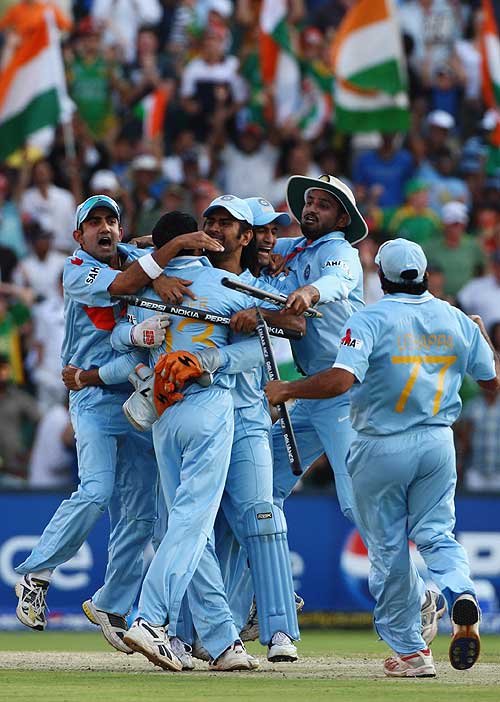
Photo Credit : Cricinfo.com
Published on desicritics.org
Sunday, 23 September 2007
The "Animal" Attraction - Why Do We Love Pets?
My personal love affair with pets began before the moment I was even conceived.
My nana (maternal grandmother, not grandpa in our part of the country) loves animals. In her younger days she nursed peacocks, deer and sundry other birds & animals back to health. The family household always comprised of a couple of cats, dogs, cows, goats, pigeons and various other species including a monkey at one point of time and a rat snake who would regularly appear to eat the pigeon or chicken eggs. All this was obviously long before the government started poking their noses into which species could or could not be allowed in family spaces.
Living a half day bullock-cart ride away from the nearest neighbours (while on the estates) made domesticating animals (for food and otherwise) a necessity.
By the time I came along, nana was pretty much restricting herself to dogs, cats, poultry and dairy animals. In most households, dogs were for guarding houses, cats were meant to keep the mice away. They were always fed a little below satiating point to keep them hungry enough to catch pests and scare away the people who had no business hovering around the gates.
Not in nana's house. Our cats & dogs were always overfed. So the dogs would sleep at the gate when they had to be guarding the compound and the cats would sleep in the attic when they were supposed to be catching mice ! All because she did not have the heart to leave them in the least bit hungry.
Nana's children - my mom, aunts and uncles - all absorbed this instant love for animals and most of her grandchildren were born to it. we were always surrounded by them and our dogs and cats were our friends too.
Even if the rest of the cousins ganged up against one, the dogs and cats would not take sides.
If you needed to cry away from anyone else's view, you could always take one of the dogs for a walk - who would silently lick your hands or cheeks (whichever was in closer proximity to their height)
If you wanted unconditional love - the dogs/cats provided that.
Non judgmental - bingo.
Non questioning - sure.
They know exactly when to come sit in your lap and when to give you an adoring look. As Dee elaborated about Zoey in Love, Grief, Pain, and a Kitten no matter how many times you push them away, they keep coming back to you.
They never judge you for anything - Feeding them late, not getting home in time, being pissed drunk, being lazy, being a few pounds overweight......
They will accompany you anywhere and everywhere where you let them and sometimes even if you don't. Our little munchkin (whom we adopted a couple of days ago) watches cricket with the husband. My husband is absolutely thrilled to have a cricket viewing partner in the same household.

They just keep coming back and give you more love. They insist on following you into the bathroom, but you don't mind since they aren't going to scrutinise your flabby thighs or beer belly. They just want to be around in your presence.
With a pet around you can never feel worthless. Because you are the world to them and they make it very evident to you.
How can you resist adoring eyes like these ?
Published on desicritics.org
Wednesday, 19 September 2007
Buying and Sourcing Spices in Egypt
Since I obviously can't cover everything in one shot, I'll just do the best that I can.
The best place to buy whole spices in Egypt - cinnamon, cloves, cardamom etc is the Khan el Khalili near Al Azhar Mosque.
There are various shops, some have better quality of some spices than others. So you may need to mix and match a bit. If you are here for the long run, then I would recommend that you keep going back to the same spice seller to build up a relationship with him and his shop. He will then start keeping aside your favourite spices for you and also give you the better quality spices which aren't ever displayed to the transitory tourist shopper.
The Attaba (spice and herbs section) market is also a great place to shop for whole spices. But not recommended to any expat in Egypt who has still not got the hang of navigating Cairo's streets & traffic (human and vehicular) or brushed up on their negotiating (bargaining) skills. Even after a year here, I prefer to accompany an Egyptian friend who does all the talking (I give my shopping list to him/her before time and quietly point to anything I find interesting)
I still get most of my whole spices from home (imported from Kerala - the best & strongest potency) except for cinnamon which I find the quality available in Egypt to be many degrees higher, especially if you like the fancy versions (all rolled up in little curls - called quills)
You can get really long cinnamon quills (1-2 feet long) at the 2 spice markets mentioned above.
Chilli powder - not really found a really spicy brand like the "Everest - tikhalal" that I use from back home. What you get in Egypt as Chilli powder is normally paprika powder and has a slight sweet tinge to it, but its not in the least bit half as hot as "Everest-tikhalal"
Dried Chillies - I have seen the Sudanese dried chillies at some of the supermarkets - they are quite potent and worth buying.
Green chillies - the fresh chillies sold in most markets taste more like bell peppers (capsicum) than chillies to the Indian palate. A couple of shops sell Thai Birds eye chillies like Maadi Fruit paradise and Miriams Market in Maadi. (It seems Alfa in Zamalek used to stock this stuff before, but there's a lot of stuff that's gone AWOL on their inventories)
Turmeric Powder, Cumin (jeera) powder, corriander (dhaniya) powder, onion powder, garlic powder are easily available. I pick up the "Nour" - Small flat round plastic boxes with red tops or the "Spicy Trade" - Tall slim round glass bottles with purple tops.
Do remember that sometimes powder is spelled as "bowder" on the bottles. Its the same thing, not a new spice :)
Spicy trade also offers baking soda (soda bicarbonate / meetha soda) and mono sodium glutamate(ajinomoto) in its range. They also sell whole spices.
The National Brand of masalas from Pakistan has started retailing here, too. They sell spice blends but only in their ultra mild versions (in Egypt). I add My India brought chilli powder to the mix, but the rest of the balance and blend is fine. The blends are very similar to Indian blends. I've seen biryani (kabsa), kheema/queema (mince), Tandoori (barbequed chicken), Broast (roasting or frying chicken), kaleji (liver), kofta, and tikka mixes among others.
They come with recipes printed on their packs. Don't be worried if you only see instructions in arabic on the outside. There will be an English version on the inside of the pack. Else you can always get the recipes online by clicking the links above.

This is what I can think of for the moment. Let me know if you are looking for anything in particular, by writing a comment on this post. I should reply within 24 hours unless I'm out in the desert :)
These spices are available at most of the major supermarkets and the local grocery store too.
Also see Papads & Pickles for more details on Indian foods.
Published on desicritics.org
Tuesday, 18 September 2007
Book Review : Cairo - The Family Guide
The current issue of the Cairo Family Guide is the 4th edition (the first edition was in 2001). It has been revised each time to update the data and make it more current & relevant.

It's written by Lesley Lababidi in collaboration with Dr Lisa Sabbahy and printed by the AUC Press. It's one book any person planning to check out the sights of Cairo on their own, or living here for more than a week should most certainly pick up.
The book is categorised location wise and then each place worth a visit in that area is listed out with complete details.
For eg. there are 3 different itineraries for the Egyptian museum depending on a person's interest. It also helps split the museum into manageable trips so as to be able to absorb maximum information.
Special attention has been given to understanding and recommending activities based on a child's age and interests. So the book is especially handy for those visiting with kids.
Maps to the areas, the closest Metro stop, the timings (including changed timings for Ramadan), Entrance fees (for foreigners, residents, students & Egyptians - yes there are multiple rates), Photography and video fees if any, (or whether they are allowed at all), the telephone numbers to that location, facilities available (bathrooms, gift shops, cafeterias) the best place to park (this is a major issue in Cairo), relevant websites if any, activities organised at that location if any, how much to tip and whom. These are just some of the gems of information that she shares about each and every location.
This is a goldmine of information especially given the monumental difficulty of gathering such data in Cairo. This is one of our few books where the book has completely lost its crispness (I don't even like the spine cracking in my books)
The only drawback is that since this is a 2006 edition some of the data has become obsolete especially with the recent adding of a digit to all land-line numbers at some of the telephone exchanges. Some sites have revised their charges (upwards of course) But the changes would hardly be in 5% of the data in this book.
So go ahead and pick up your own copy today. At 70LE it's a steal! Make sure it is a blue coloured bind with the picture of children sitting in a donkey cart. This is the latest edition. Many smaller bookshops still stock the older versions with the green colour binding. The information in those would be about 25-30% irrelevant and/or obsolete.
The details on the AUC Press page are available at here.
You can buy it at any major bookstore in Egypt. Its one of the most popular books. Or even buy it off Amazon.
Published on desicritics.org
Wednesday, 29 August 2007
Book Review : The Other Side of Me, Sidney Sheldon

The book starts with his impoverished childhood during the Great Depression and surprisingly ends before his meteoric rise as a successful novelist.
Born Sidney Schechtel in Chicago in 1917 to German & Russian parents, Sheldon's life had more ups and downs than a month of roller coaster rides. A long time sufferer from manic depression or bipolar disorder as it is now called, he often turned away at critical moments from paths that were just opening up to him.
Success took time coming his way and even when it did, it didn't stay long. (Not until his writing career took off, then there was no looking back) In his words - "Success is an elevator that moves up and down". His ups included having three musical hits playing simultaneously on Broadway, the Oscar and the Screen Writers Guild award for Best Musical for "Annie Get your Gun" The downs included long periods of unemployment and blacklisting by the studios.
There are so many anecdotes about so many famous people that are a pleasure to read. Groucho Marx was an extremely close friend and also Godfather of Sheldon's daughter Mary. Having seen the Hollywood industry as a writer, producer and director his insights are precise and delightful.
My only disappointment was is that I wish he had written a part two before his death on January 30th, this year. He does throw a few morsels about his writing life experiences, but they just aren't enough for his adoring fans.

I highly recommend the book to all Sheldon fans. This is the first autobiography I have ever read which I did not put down even once.
Published on desicritics.org
Saturday, 28 July 2007
Book Review : Ice Candy Man
In 2000, one of the few films that moved me to tears was Deepa Mehta's "1947 : Earth" Coming from the South of the Vindhya's, the Partition was something mentioned in passing in text books. We did not know any affected families and hardly anyone down South spoke about this bloody episode in India and Pakistan's shared past.
According to Richard Symonds 1950, The Making of Pakistan, London, "at the lowest estimate, half a million people perished and twelve million became homeless".
1947 : Earth brought this part of our history to life and I wanted to read the book which spawned the movie. (Everyone knows that books are better than the movies they inspire.) This was on my "To Read" list for almost 4 years before I bought the book and it took me another 3 years to read it. Even reading the book itself took over a month, because it induced strong feelings of despondency, depression and immense sorrow.
The problem with history books is that they tend to dehumanize history, apart from the fact that history is interpreted by the writer for his/her own convenience. Bapsi Sidhwa's Ice Candy Man manages to avoid both these cons. The story is semi fictional but it is also based on her own experience and that of Rana Khan.
The entire story is told through the eyes of Lenny Sethi (Sethna in the movie) from the time she is 7 to early teenage. Lenny is a Parsi girl. Her religion and age does play a pivotal part in the story telling because most of the events around her do not affect her or her immediate family directly, although it affects the lives of everyone else around her.
As Ralph Crane puts it "It may be that the atrocities of 1947 are best seen through the innocent naive eyes of a child, who has no Hindu, Muslim or Sikh axe to grind. . . Lenny is free both from the prejudices of religion and from the prejudices against women and the constraints she will be subject to as she grows older."
Lenny's naivety is brought home often, like when she comes to know that her mother and Electric aunt are acquiring petrol and immediately jumps to the conclusion that they are the ones responsible for setting all the fires in Lahore.
Sidhwa's characters are extremely well etched from Ayah, to masseur, to Ice Candy man, to Imam Din to Mucho, to cousin, to Godmother to Hari (later Himmat Ali). All these characters play an important part in Lenny's life. Each of their religions takes centre stage as matters escalate. And the rich detailing of each character makes the reader commiserate with the plight of each of the "victims".
Her imagery is excellent and brings each scene to life. Visualising Rahul Khanna, Nandita Das and Aamir Khan in the roles of Masseur, Ayah and Ice Candy man simply helped the process.
An extremely touching and poignant story. Khushwant Singh (A Partition survivor himself) says this book deserves to be ranked amongst the most authentic and best books on the partition.
I would highly recommend this book to everyone. It would help one start to comprehend at what cost our Independence was achieved and August 14th/15th can no longer be viewed by most as "just another dry day".published on desicritics.org
Sunday, 22 July 2007
Book Hunting in Cairo
Thought I would just do a quick listing & brief review of the bookshops I like in Cairo which may help you out if you are searching for something. Do remember, I was focussed on travel books. Fiction titles in Cairo I find very expensive compared to India & they take time to come into this country by the time they are cleared by the censor. I get my fiction fix from India via whoever is visiting.
1. The AUC bookshop on the AUC main campus is my absolute favourite. I spend at least 1 day each month at this location checking out their new titles & re-browsing some old ones. The AUC-(American University in Cairo) has its own printing press and they bring out an amazing array of Egypt related books written by Subject Matter Experts. Coffee Table Books, history, travel, religion, jewelery, fiction, Egyptian literature, architecture .... the variety of topics they cover is endless. Highly recommend that you visit this bookshop if you are looking for a book related to Egypt.
They have a second outlet in Zamalek too, which I have not yet visited. They stock other (Non-AUC press) titles too as well as International Newspapers. They have a very large collection of Lonely Planet guidebooks, but don't stock DK. They are quite accommodating about ordering books & calling you when something you want has come into the store.
Tip 1 : They have a sale twice a year, where some books are sold at huge discounts but everything else is on at least 20% discount.
Tip 2 : Use this excuse to see the wonderful AUC grounds and palace which has been converted to the Administration block. Carry some form of photo id which you will need to leave at the gate if you are not a student.
Tip 3 : If you are planning on spending more than a week in Cairo (as a tourist or an expat moving into this country) and have more than a passing interest in sight seeing, definitely pick up Lesley Lababidi's - Cairo - The Family Guide This is the 2006 edition. The 2007 edition may be on its way. I've used my copy so much, its actually gone soft and has dog ears. (Anyone who knows me, knows I like my books to be crisp to the touch - always)
Tip 4: You can buy an AUC bookstore membership card for 50LE. This will give you a 10% discount on your purchases. (I think its valid for at least a year. Worth the expense if you plan to buy more than 500LE worth of books from them.
2. Diwan Bookstore on 26th July Street in Zamalek, is a favourite with Expats for good reason. They have a wonderful cross section of books. A section dedicated to books in French and German and a very large section of books for children and a seperate one for teenagers. If you are looking for Children's books with an Egyptian theme (for gifting back home) this is the place to head to.
They have a little in-house cafe which serves lovely coffee and light snacks. Books from the store are not supposed to be read at the Cafe, but they have a section of books and magazines for those who want to read while sipping coffee.
3. The BookSpot is a lovely bookstore on Road No. 9 in Maadi run by my friends Sigrun and Mandy. This is a bookstore which makes you feel completely at home. There's complementary tea or coffee on offer and the best part of a visit to this shop is to catch a chat with either Mandy or Sigrun. You can even buy and order books from them online and collect them at your leisure or have them delivered to you. They take back second hand books and sell them at a discounted rate which is a boon for speed readers.
The atmosphere here is extremely friendly. Many disoriented/culturally shocked Expat women have found solace, friendship and like minded souls through this shop and its owners.
4. Kotob Khan is another gem on Lasilky Road in Maadi. They were recently featured on Al Jazeera TV for their service to the community. They organise documentary nights, book of the month readings, debates and other events, some of them in collaboration with Pen Temple Pilots. They have a wide collection of English and Arabic books and some travel books among others.
5. Volume 1 is a nooky little bookshop located off Al Sawra street in Mohandaseen & behind Victoria College in Maadi. The Mohandaseen shop has an extensive collection of Travel books, a large collection of AUC press publications, childrens books and fiction. They have a large stationary and gift section too.
6. Librairies Renaissance also on al Sawra street stocks only French publications but boasts a very large collection of fiction, children's books, cookbooks and other topics all in French.
7. Adam Bookshop at the Maadi Grand Mall in Maadi is a really tight small spaced bookstore. They have a decent collection of books, that spill all over the store so there's not much space to walk around. If I understand right, they were one of the first bookshops in Cairo to cater primarily to expats.
8. Virgin Megastores has a very large extensive collection of music & movies but I wouldn't say the same for their books. Yes, they have all the popular stuff but if you are looking for something just a little out of the way then this is not the place to look. They do not take orders. (given the size of their chain, I did expect them to do this) Can't blame them, they are only following a "big retail business" rule - stock fast moving items only. If you are looking for bestsellers in any genre you can find it here. But the store completely lacks the intimate feel of all the other bookstores in this list. You are treated as a commodity not a customer.
In the other bookstores the personal touch with the shop assistants, those manning the counter and in some cases the owners themselves makes a book lover want to keep returning to those stores. The shop assistants and the owners are happy to discuss the merits and demerits of a book and recommend further or alternate reading. At Virgin, they look up their computer to see if the book you want is in stock or not. That is the extent of Customer interaction. Lets not start talking about service. Ok, end rant. I like chain stores like CarreFour and Spinneys for my groceries but for my books I like a personal touch. I have nothing against chain bookstores. I think Crossword in India has managed to balance the chain aspects vis a vis the personal touch very well. Although Strand is still a personal favourite and I have my little nooks in every city I've lived in.
9. Alfa Markets especially the one in Zamalek do stock a fair amount of books and at some point had a good collection of DK Eyewitness Guides. But when I checked last it looked like they were having a clearance sale of all their books.
Prices are almost the same across these bookshops with a few disparities. But they are not large enough to warrant a trip to another part of town unless you are planning to buy in bulk.
I did not find the book I was looking for anywhere. Finally I turned back to the last resort Amazon.com The books were available at a discount but the shipping rates are killing me !
Monday, 23 April 2007
Kim's Blog featured on SharmWomen
http://sharmwomen.com is an independent site which only lists blogs they find to offer true value for their readers. Bloggers can't recommend their own sites or influence the decision to get listed.
Hence I'm pretty kicked about this. :)
Kim (Karishma Pais)
Monday, 16 April 2007
Flamenca - A Marriage of Spanish and Oriental Music
For the last few months, the only "local" music I've listened to or heard were of the Lebanese Music Video variety, which at its best is comparable to an "Item Number" and at its worst is worse than those Punjabi videos on ETC.
Fortunately this entire imagery associated with local music has been completely replaced by an infinitely superior quality and variety of music. Flamenca Cairo, a group of nine instrumentalists and a vocalist perfomed to a full house at the El Sawy Cultural Center last Friday.
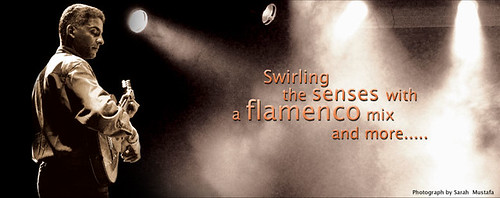
The group was founded by Wael Khedr (who is also the Lead Guitar/Guitar Soloist) in 2003 with traditional Flamenco music and some Latin themes. It was slowly developed to have more oriental flavor with the addition of some oriental instruments. Now, Flamenca has several unique pieces of music where this marriage between flamenco and oriental music is clearly evident.
Amr Darwish plays a mean Electric Violin. The jugalbandis between him and Wael were outstanding.
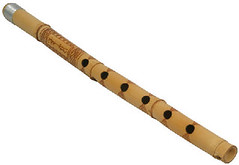
Raaft Farahat plays an instrument called the Kawla which is an Arabic Flute.
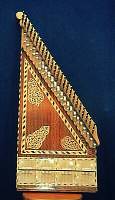
Yamen Abdallah plays the Qanon which sounds like a Santoor - reminiscent of water trickling down a slow waterfall.
Omar El Toudy on Keyboards looked so much like those Senior Masterjis who play the keyboards in desi orchestras. Sameh Ismael and Sherif Kamal are the percussionists, who play a wide variety of instruments some familiar, some not so familiar and some completely tangential like the stool that Sherif was sitting on. Saief Eldawla on the Drums and Moustafa Geuida on Base Guitar completed the instrumental part of the ensemble.
Ahmed Samir intermittently provided vocals to the instrumental pieces. What a voice! Powerful and controlled. Although I could barely understand a word of what he was singing, I could feel the strong emotions and sentiments behind them.
The whole ensemble just blended together so beautifully. It has been a long time since any music has actually touched me. Flamenca's music was moving, it actually spoke to every member of the audience. So the repeated requests for an encore and the standing ovation that followed at the end was no suprise at all.
You can dowload and listen to some of their music on their site. http://www.flamencacairo.com/
Image Sources:These pictures have been taken from the Flamenca website http://www.flamencacairo.com/ and through Google Image Search http://images.google.com/
Published on desicritics.org
Friday, 16 February 2007
Street Food: Egypt vs India
When I first considered writing about street food in Cairo, the few people I knew in Cairo had a good laugh and cautioned me that having just arrived in the city I was completely setting myself up for the curse of the Pharaohs. Well, being a desi and with an ability to eat the Pav Bhajis and Paani Puris and Vada Pavs on the streets of India, the streets of Cairo posed no threat at all, so I was all set to explore Cairo by tasting everything it had to offer. (But I did tuck a strip of lomotil into my wallet to be on the safer side.)
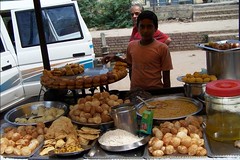
There's such a variety of snacks, meals, quick bites and drinks on offer on the streets of Cairo that it would be impossible to try them all in a few days, but I did manage the highlights.
A good day begins with a good breakfast. A fuul or tamiya sandwich is what is considered ideal. I tried these at Arzak in Maadi Grand Mall, from a stall near the Sultan Hassan Mosque and Moqattam courtesy the Pen Temple Pilots and a couple of other street carts. I loved them all. Fuul is paste of cooked fava beans spiced to your liking with maybe a few fresh veggies thrown in too for texture.
The tamiya is a deep fried patty of the same fava beans. But they taste completely different in this form than as fuul. The tamiya is flattened and stuffed into the eish (pita bread) with a little hummus or tahini and more fresh veggies.
My favorite is a little tahini, a little fuul, tamiya and pickled brinjals all stuffed into one sandwich. This makes for a messy eat since the ingredients tend to squish out the sides, but to quote Rachel Ray, it's completely "yum-o!"
These sandwiches can also be stuffed with omelettes, french fries and all kinds of combinations. At 1-2 LE each they are an absolute steal.
It's interesting to watch the sandwich guy stuff the assortment of ingredients into the bread. It reminds me of the anda parathawala outside IIT Delhi who nimbly cracks and throws a raw egg between two layers of a paratha while the paratha is frying on the pan, all in one single flowing movement to produce the most scrumptious anda parathas ever.
I don't think India has a direct comparison in terms of taste for fuul or tamiya. The closest similarity I could think of was boiled and smashed peas which are used as a base in some chaat preparations. Also the tamiya is a bit like a dhalwada.
For lunch in Cairo. I'd go for Koshary. Actually, I can eat this for breakfast, lunch and dinner and never get tired of it. It's considered the common man's food, but I've also heard someone say they think it should be named Egypt's National Dish. A combination of pasta, lentils and tomato sauce topped with fried onions. Its light yet filling, nutritious, quick, healthy and ohhh so tasty. The guy who makes the koshary normally has all the ingredients ready and warm. When an order is placed he mixes it all in a jiffy and its mouth watering to see how he deftly assembles the dish. The crunchy onions on top are better than cherries on a cake.
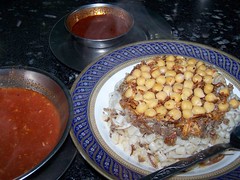
When it comes to Koshary every single person you meet in Cairo will tell you that they know the "best" place to eat it and everyone claims that their place is better than anywhere else. On recommendations, I've tried Arzak in Maadi , Abou Yoosef in Mohandaseen and street stalls all over the city. Although I loved them all, I must confess I'm a little partial to El Omda's Koshary topped with Chicken Shawrma because it gives me my meat fix too.
Although there's no confirmed Number One Koshary in Cairo, what is certain is that a good hot steaming plate of Koshary can warm the cockles of anyone's heart. Koshary is complete soul food and this is what I will crave the most when the time comes for me to leave Egypt.
For mid meal snacking there are umpteen options all over town: baked sweet potatoes, roasted nuts and seeds. A friend of mine said she would rather buy one roasted sweet potato from the street vendor than a kilo & a half from the grocer for the same price.
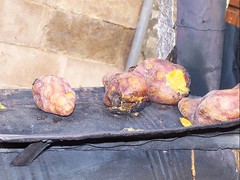
They are that delicious. For the thirsty there are a variety of juice stalls to try from. The aaseer asab (sugarcane juice/ghanne da ras) works perfectly to counter the dehydrating effects of Cairo's heat. It replenishes body salts, it's tasty and completely refreshing with a strong natural sugar-fix to it.
By dinner time, most Cairenes are more relaxed and have the time and leisure to wait for a good meal to be prepared. If you find yourself with the time to enjoy a meal, then head down to one of the kebab houses, order your hearts fancy and wait for the wonderful steaming dishes to be brought to your make-shift table on the street.
The two most recommended kebab places are Farhat at Khan el Khalili and Mohammed Rifai at Sayeda Zainab. You can order various meat based items here. Kebabs and kofta are the most popular combination. In Egypt, Koftas are rolled and skewered minced meat with spices. Kebabs are roasted marinated chunks of meat. Chops, roasted chickens and grilled hamam (pigeons) are also on the menu at places like these. I'll admit I haven't had the courage to try the pigeon yet, but all the other meat that I've eaten, I've enjoyed.
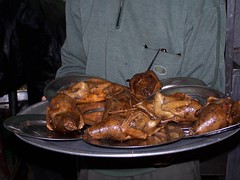
While the tantalizing smell of your meat grilling in the open oven teases you, you will be served eish (bread) with a choice of salads. Green salad, tahini, hummus or babagannoug. My recommendation: control your hunger pangs and ignore the bread until the meat arrives otherwise you may be full before the main course arrives. Sip on the shorba (served cold and spicy) instead, it will increase your appetite.

India though, has a larger variety of kebabs in all kinds of forms made from all kinds of meat. Kareem's near the Jamma Masjid in Delhi, Tunde Kabab in Lucknow, Chawla's Chick Inn in Chandigarh are just three of my favorites. Tandoori chicken is perhaps the best known export from India but that's just the starting point of Indian kebabs. Tender reshmi kebabs, boti kebabs, gilauti kebabs with ulte tawe ka paratha. Just writing their names down makes my mouth water. The varieties of kebabs available in India are as numerous as the varieties of chaat or parathas or any other dish that you may mention.
If you didn't know yet, India has more cuisines styles than it has states, so there's variety in everything. Other popular street food in India includes Dosas, Idlis, Chole Bhature, Samosas, Vadas, Vada Pav, Missal Pav, Halwas.... At the risk of repeating myself - the varieties are endless.
Although I have broadly categorized Egyptian Street food as breakfast, lunch & dinner items, when you eat these treats can be as flexible as meal times in Egypt.
Is Indian Street Food better than Egyptian Street Food?
Well, Indian food is spicier and more chatpata, but I wouldn't venture to say that either is tastier than the other. They are both almost completely different in flavour but both are excellent.
The only thing I would stress on is that - to eat these street food delicacies, you should be standing on the road, inhaling some diesel fumes, amidst the honking of taxis and the food should have the flavor of the street on it. No five star hotel can ever make these same items taste even half as good. Be brave, ignore the hygiene factors, the occasional fly in the hummus and dig in. It's worth it.
Bon appetit!
Published on desicritics.org
Wednesday, 14 February 2007
M T R Foods Sold for $100 Million
MTR Foods has taken a Scandinavian turn. It's not US spice king McCormick that will buy MTR Foods as speculated earlier, but the Norwegian foods-to-metals group Orkla.
Shock/dismay/sadness/happiness.... a series of feelings ran through me when I read these headlines in Finance Asia & the Times of India.
Shock since I did not have any idea that MTR was up for sale, being in this faraway land. Dismay & sadness that a Scandinavian Company has taken over at the helm of MTR. What do Scandinavians know about Kannadiga cuisine? Happiness that MTR as a brand was worth 450crore, three times its current turnover. But mostly I feel sad. What Orkla will do with the brand & the product compositions remains to be seen. But things can never be the same.
Why am I writing on business news which I normally just read & never write about ? Because I have a deep personal connection with MTR. To me, MTR is like the khansama from an ancestral kitchen who keeps giving me treats, tips and tricks to turn out better food in my own kitchen.
My love affair with MTR began when I moved to Bangalore in 1999 & was introduced to the Mavalli Tiffin Rooms in Lalbagh. The institution is over 80 years old and produces some of the best, most authentic South Indian Vegetarian cuisine ever. There is always a long line of people waiting to get in. Right from 6:30 in the morning when it opens. Fluffly idlis, crisp dosas, the rava idlis that they popularized. Words cannot do justice to their piping hot sambhars and other yummy food.
Three floors were not enough to house their customers, and they later branched out into a fast food principle based "Namma MTR" in Bangalore & Dubai to keep up with the demand.
MTR pickles found pride of place in my kitchen right next to the pickles that my mother and grandmother sent me. MTR spice powders and masala mixes were the number 1 choice if I did not have the time to make my own.
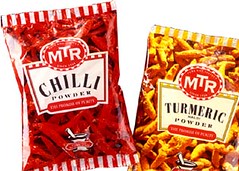
When I left for the US, half my luggage was MTR instant Bisibele Baath mix on request from several colleagues who were missing the "taste of home".
By the time I returned they had vastly increased their range and had also introduced the "Ready to Eat" line. Heat and eat, even simpler than the "Instant Mix" and much less oily than a lot of other brands prevalent in the Indian market.
When we moved to Cairo, a large part of our shipment consisted of MTR instant mixes - rava idli, dosa, upma, gulab jamun among others. From Soups to Ready mixes, to Papads to Chips to Ice Cream mixes to Pickles to Ready to eat and Frozen Foods - MTR prepares and sells them all to their hungry customer base.
Their forays into North Indian food and Malayali food can be forgiven since they seemed to manage a pretty admirable job with those items too.
The restaurant and the packaged food business were separate entities. As of now there isn't much clarity on whether the restaurants will also belong to Orkla.
I hope Orkla does not tamper with the product compositions because they have been perfected with a lot of care. I pray they do not destroy the brand completely like other MNC's have tried to do with Indian Acquisitions. And I wish they will start exporting to Egypt.
Published on desicritics.org
Book Review : National Geographic Series - Holidays Around the World: Celebrating Diwali and Ramadan
Author Deborah Heiligman has embarked on an ambitious "Holidays Around the World Series" with National Geographic
Aimed at 6-9 year old children the series is rich in photographs from around the world and lower on textual explanations, letting the pictures speak for themselves.
Celebrate Ramadan & Eid Al-Fitr with Praying, Fasting and Charity and Celebrate Diwali with Sweets, Lights, and Fireworks are the first 2 titles in the series.
Deborah has collaborated with a Consultant for each book who personally celebrates the festival being discussed.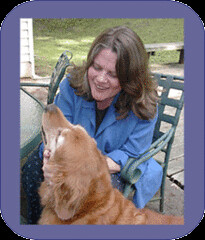
I'm not sure what the scope of these consultants was though, because I spied a couple of technical errors in the book on Diwali. For example the Taj Mahal is called a mosque, Lord Ganesh is said to symbolise prosperity, the meanings of deepa and vali have been interchanged. The Consultants could have been limited to just writing the afterword instead of proofing the text of the whole book.
I'm not too sure about the exact technicalities in the book on Ramadan because whatever I have viewed has been as an outsider looking in. Although, I have been able to observe it in greater detail here in Cairo, where the sahour's and iftars are celebrated even in 5 star hotels. The entire city fasts, the timings turn topsy turvy. Offices close earlier. Unlike India where most praying and fasting happens inside closed doors of houses and mosques, in Cairo the sheer numbers forces them onto the street even during the regular Friday noon prayers.
The pictures are amazing and well laid out. For someone who celebrates either of these festivals, the pictures will seem incomplete because Diwali there are so many more aspects than can be represented in a 32 page book. But for someone who has no idea about Diwali, Ramadan, Islam and Hinduism, this is a very good introduction. I would have loved to compare these 2 books with the books on Hannukah or the Passover which I do not know about as well as these 2.
I especially loved the satellite pictures of India on Diwali and 6 days later showing the difference in intensity of light between these days. The pictures in both books represent an excellent geographic spread.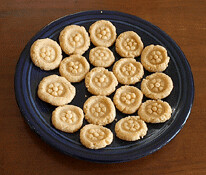
There is a recipe in each book that a 6-9 year old can easily help an adult assemble. Children who see these books will be instantly attracted and it could be a great way to initiate dialogues into cultural differences.
The books are an excellent buy for someone who is trying to introduce children to an alternative culture and festival. Priced at $15.95 per hard cover version, the entire series will be a wonderful addition to any Children's or School Library.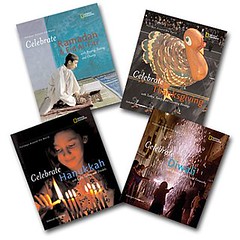
Published on Desicritics.org

